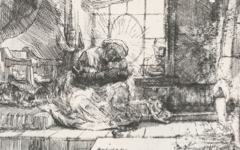Rembrandt’s Woman with the Arrow (1661)
Rembrandt's Woman with the Arrow appears mysterious on the superficial level and scholars have long debated what it represents.1 It is now agreed that the nude holds an arrow though her grip appears so light, her hand could hardly be holding anything.
Click next thumbnail to continue

L: Rembrandt, Woman with the Arrow (1661)
R: Rembrandt, Nude Woman Seated (c.1660) Pen, ink and wash on paper. British Museum, London.
Click image to enlarge.
It is known to be based on an inital sketch done after a model while Rembrandt was teaching students in his studio (near left). In the drawing she holds a rope suspended from the ceiling, a common device in studios to ease the strain of an awkward pose. The rope has become the arrow. Most significantly, though ignored because it appears to lack any meaning, her foot on the far side has slipped down the other leg closer to its ankle (far left).
Click next thumbnail to continue

L: Rembrandt, Woman with the Arrow (1661)
R: Rembrandt, Self-portrait as a Beggar Seated on a Bank (1630)
Click image to enlarge.
This then links the etching to another that Rembrandt made thirty years earlier of himself seated as a beggar. See how Rembrandt's foot on the far side has its sole turned towards us, like hers, while close to the other foot. The reason for this is that both images are based on the same source.2
Click next thumbnail to continue

L: Rembrandt, Woman with the Arrow (1661)
R: Raimondi, Portrait of Raphael (c.1510-20) Engraving on paper.
Click image to enlarge.
Their origin is Raimondi's Portrait of Raphael (c.1510-20) in which the master sits on a studio ledge, legs crossed with the sole of a foot facing us. The nude is both "Raphael" and "Rembrandt", artist and model, male and female, holding an arrow in place of both the rope and Rembrandt's burin, an etching tool with a sharp, arrow-like ending. That's why her back is turned. She is "etching" the background, with her arm extended. Her grip is light because the tool is imagined.
Click next thumbnail to continue
In the background is a mysterious face, out-of-scale, out-of-place and much-discussed (left). It has been called Cupid to her Venus, Mark Anthony to her Cleopatra, but it is clearly to my mind Rembrandt's.3 Clifford Ackley almost suggests as much in describing its "fleshy face with coal-black eyes and a pudgy nose" and relating it to Rembrandt's early Artist in His Studio.4 It must be "Rembrandt" because the nude is etching himself. She combines his mastery with his female powers of conception.5 The artist's little head is "an etching" which is why he is so small, appearing from the dark interior of a tent, a common visual metaphor in art for the mind.
See conclusion below
The difference between what all art students had to do and what Rembrandt did was put well by Clifford Ackley who, though unable to ascertain the "narrative", described how Rembrandt conceived this print sitting next to his pupils in the studio. "While his students worked to discipline their powers of observation, Rembrandt gave his own fantasy free rein to carry him and his audience far away from his modest...studio." It is an important distinction. While he didn't actually roam that far from his studio after all, he certainly didn't copy the exterior world either. Only students and non-poetic draftsmen do that.
More Works by Rembrandt
See how Rembrandt concisely expresses the underlying idea of art in a Roman myth

Rembrandt’s Lucretia (1666)
Notes:
1. Wolfgang Stechow, "Rembrandt's Woman with the Arrow", Art Bulletin 53, Dec. 1971, p. 487
2. Simon Abrahams, "Rembrandt's Self-portrait Beggar Seated on a Bank (1630)" on EPPH.
3. Stechow, pp. 488-92
4. Ackley, Rembrandt's Journey. Painter. Draftsman. Etcher. (Boston: Museum of Fine Arts) 2003, p. 290
5. Artists often pun on conception because the word is also used in several European languages to describe an initial image in the artist's mind. The Virgin Mary and her Immaculate Conception is one of the most common subjects for it. See, among other examples, Michelangelo's Vatican Pietá (1499).
Original Publication Date on EPPH: 11 Oct 2013. © Simon Abrahams. Articles on this site are the copyright of Simon Abrahams. To use copyrighted material in print or other media for purposes beyond 'fair use', you must obtain permission from the copyright owner. Websites may link to this page without permission (please do) but may not reproduce the material on their own site without crediting Simon Abrahams and EPPH.




